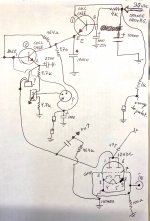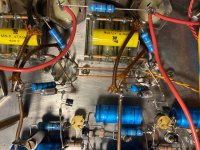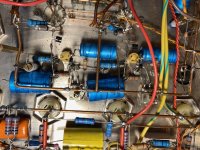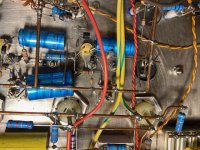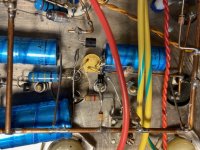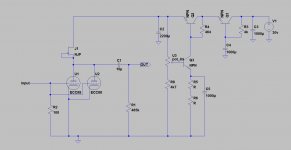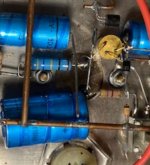Hello all. I need help with this old preamp. It has a tube MC section, heavily regulated, using two 6DJ8 tubes, one for each channel. MC section is a separate entity, before the MM section, so two separate inputs. MC section started to motorboat. Signal goes thru, and the volume is fine. I checked the plate voltage and it's only 30v, coming from the PS, and after the regulators I get only about 10V on 6DJ8 plates. Knowing Jadis and their idiosyncratic designs I expected something strange but not this. I checked all electrolytes around, and they all check fine, with ESRs in .26 ohm range, and uF within 5%. There is a pot on each plate, to regulate the voltage, I assume. Perhaps they have to be tweaked. Since there is no service manual available, I'm shooting in the dark. Any help is appreciated. Thank you.
Thx
I’ll try. Thx
Without a circuit its difficult. Maybe you could draw something.
I’ll try. Thx
Turned out it was a bad tube that my tester showed as good. Put in new tubes and all of that thump stopped. I can breathe again.
No
No, it wasn't. Noise disappeared for a couple of hrs and now came back. Only in the left channel.
Turned out it was a bad tube that my tester showed as good. Put in new tubes and all of that thump stopped. I can breathe again.
No, it wasn't. Noise disappeared for a couple of hrs and now came back. Only in the left channel.
Drawing
Hi. I'm attaching my crude drawing a a few photos. Noise is a combination of high-pitched whine and "hr-hr-hr-hr-hr". I think it's a regulator or any associated components. There is a transistor attached to it but it's unmarked.
Without a circuit its difficult. Maybe you could draw something.
Hi. I'm attaching my crude drawing a a few photos. Noise is a combination of high-pitched whine and "hr-hr-hr-hr-hr". I think it's a regulator or any associated components. There is a transistor attached to it but it's unmarked.
Attachments
Hi Mark. Took the liberty to redraw your circuit. It is pretty standard and nothing really points out towards suspicious components. I would think R5/R6 are zeners but unimportant.
The fact that the tube replacement brought a temporary reprieve makes me suspect the socket. Replace it if possible as those are difficult to clean properly if oxidised. Perhaps a metal brush can also help.
If that does not help check/replace zeners and decoupling cap. Next in line are all the transistors. The Fet ccs is likely for 10mA, so a K170BL, selected or with an added resistor will be a good match.
The fact that the tube replacement brought a temporary reprieve makes me suspect the socket. Replace it if possible as those are difficult to clean properly if oxidised. Perhaps a metal brush can also help.
If that does not help check/replace zeners and decoupling cap. Next in line are all the transistors. The Fet ccs is likely for 10mA, so a K170BL, selected or with an added resistor will be a good match.
Attachments
Wow!
Analog, many thanks! I'm an artist by trade, but when it comes to interpret circuits, I'm very crude ))) I will proceed, a bit later, with kids and schools and the virus it's gotten a bit tense all of a sudden...
Analog, many thanks! I'm an artist by trade, but when it comes to interpret circuits, I'm very crude ))) I will proceed, a bit later, with kids and schools and the virus it's gotten a bit tense all of a sudden...
JP
Analog, you did it all great, except each tube is separate, with it's own regulating circuit. I will check the socket, but I tend to think it may be something else. The noise does not start right away, I have to check how long it takes. It may be a cap? Or whatever goes out of whack when it warms up sufficiently. What a pain I got myself into...
Analog, you did it all great, except each tube is separate, with it's own regulating circuit. I will check the socket, but I tend to think it may be something else. The noise does not start right away, I have to check how long it takes. It may be a cap? Or whatever goes out of whack when it warms up sufficiently. What a pain I got myself into...
Hi Mark. Took the liberty to redraw your circuit. It is pretty standard and nothing really points out towards suspicious components. I would think R5/R6 are zeners but unimportant.
The fact that the tube replacement brought a temporary reprieve makes me suspect the socket. Replace it if possible as those are difficult to clean properly if oxidised. Perhaps a metal brush can also help.
If that does not help check/replace zeners and decoupling cap. Next in line are all the transistors. The Fet ccs is likely for 10mA, so a K170BL, selected or with an added resistor will be a good match.
I think I failed to mention that music signal is fine, but it accompanied by this strong noise, sometimes with motorboating. I turned off my Wi-Fi router and motorboating seemed to go away, but the whine and hrrrr remained.
Check all the soldering re-tinning every joint if you can. Check the soldering on the tube sockets.
Solder
Will do
Check all the soldering re-tinning every joint if you can. Check the soldering on the tube sockets.
Will do
Got the numbers for all the parts. The only one that’s difficult to find is the jfet SK43. Zener bzx55c 6.8v, 1n4007 diode, 2n1711 transistor, a few resistors and caps are readily available.
I had a look at the photos and it appears there are two electrolytic capacitors that are not connected to what looks like the ground bus section. I've posted photo of the first one I saw, the other connects to the same bus and is further to the right.
Attachments
Last edited:
Correct
Hi. You are correct. I desoldered them to measure them ))) Soldered back.
I had a look at the photos and it appears there are two electrolytic capacitors that are not connected to what looks like the ground bus section. I've posted photo of the first one I saw, the other connects to the same bus and is further to the right.
Hi. You are correct. I desoldered them to measure them ))) Soldered back.
- Home
- Amplifiers
- Tubes / Valves
- Jadis JP80MC help needed
